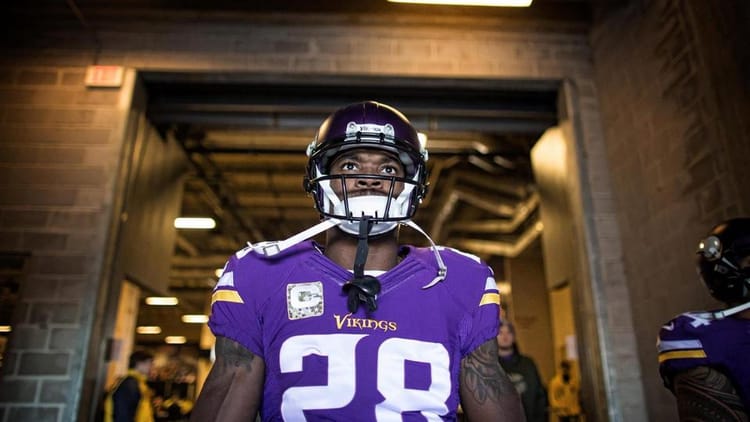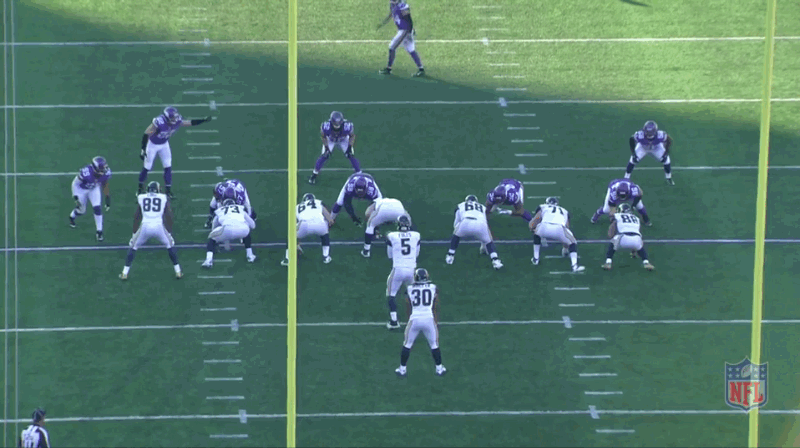What Went Right, Week 9: Vikings vs. Rams

The Minnesota Vikings don’t pass the ball particularly well (210.6 yards per game), they don’t score a ton of points (21 points per game), and they don’t have an explosive offense (5.15 yards per play). Despite their deficiencies, the Vikings are 6-2 and climbing in the NFC playoff standings. They’re tied with the Green Bay Packers for first place in the division. They’re currently on a four-game win streak. They’re the second-best scoring defense in the league. And yet, they’re three-point underdogs to the Raiders this weekend.
Why? Well, it starts with Derek Carr, who is playing the best football of his young career (19 touchdowns to just four interceptions on the year). Their offense is scoring over 26 points per game, while their defense continues to shut down opposing running backs, allowing just 97 yards per game. Though they’re 4-4, the Raiders are a team on the rise with the weapons to challenge the Vikings on offense, defense, and special teams.
Around the Internet, a mere seven of 32 experts are picking the Vikings to win on Sunday. On paper, it makes sense — the Vikings are statistically inferior to the Raiders in a number of offensive categories. If the game becomes a shootout, it’ll be difficult for Minnesota to keep up. But as they showed last week against the Chicago Bears and this week against the Rams, their strengths far outweigh their weakness. Whomever (and wherever) the Vikings play, their running attack and team defense can carry them to victory.
Adrian Peterson Lives
Through eight games this season, Adrian Peterson leads the league in rushing. He’s on pace to become the first 30-year-old rushing champ since 2004, and his 758 yards put him on pace for 1,516 at the end of the year. Thanks to improved play from the offensive line and more assertive running from Peterson, the Vikings currently field the league’s sixth-best rushing attack. They relied heavily on Peterson against the Rams, giving him the ball 29 times. The running back delivered, and his solid outing paved the way for the 21-18 overtime victory.
Here, on Peterson’s lone touchdown, the Vikings run what appears to be a version of G-Lead. Much like Power, which Norv Turner dialed up often against the Bears, G-Lead involves a pulling lineman. However, the play-side guard pulls to the edge of the formation, making this a faster-developing play against a defense loaded with speed. The excellent Matt Bowen, who now writes for ESPN, recently detailed G-Lead in his “Football 101” series of articles:
[quote_center]The “G” Lead is run out of a two-back look with the frontside (or play-side) guard pulling to kick out the primary support defender and the fullback leading up through the hole.[/quote_center]
The Vikings opt to run this play with “13” personnel (one running back, three right ends) and put the strength of the formation to the short side (right) of the field. Although they’re missing a fullback, MyCole Pruitt serves as the lead blocker, taking out the most immediate threat at the end of the line of scrimmage. Like Power, the play-side tight ends and tackle block down, while the back-side linemen work to cut off the flowing defenders.
In order for the play to work, Kyle Rudolph and T.J. Clemmings have to execute a perfect double team on the down lineman and outside linebacker. At the snap, Clemmings seals the defender lined up inside, and Rudolph works his way to the second level, getting just enough of a chip to prevent Mark Barron from penetrating into the backfield.
The most important piece of the puzzle, however, is Mike Harris. The 6-5, 310-pound right guard pulls immediately at the snap and leads Peterson to the outside of the formation. His presence alone is enough to clear space for Peterson to the end zone, and his final block seals six points for Minnesota. As you can see from the film above, eight Rams defenders are essentially “blocked” by three Vikings — the result of the play’s design into the short area of the field. When offenses choose to attack the condensed space, defenses are put at a disadvantage; less running room and increased traffic make it difficult to take proper tackling angles.
Vikings Defense Sticks Together
Linval Joesph is the heart of the Vikings’ defense, and the NFC’s Defensive Player of the Week helped lead Mike Zimmer’s team to a win last Sunday. Together, he and his teammates held Rams running back Todd Gurley to 3.7 yards per carry and shut down a one-dimensional St. Louis offense. After the game, he shared his admiration of the unit with reporters and media members:
[quote_center]“It’s more of a comfort level,” Joseph said. “I just want everyone to be great and I want everybody to do their job. If I can help, I’m going to try to help. That’s just the way I am. I’m just bringing that out more this year because we’re all one heart. We all have to stick together. I’m going to do whatever I have to do to help this team.”[/quote_center]
On Sunday, Linval did everything he could to help the team. Players seemed to feed off his energy, and that chemistry paid dividends when Zimmer entrusted his defense to stop the Rams in overtime.
On St. Louis’s first and only possession in extra time, the Vikings stopped Gurley for a loss of six yards. At the snap, Joesph works laterally off the center’s inside leg, using his hands to prevent the pulling guard from executing a reach block. His strength and penetration into the gap forces Gurley to cut back, and Harrison Smith takes an excellent angle to prevent the running back from bouncing outside.
By hanging onto Gurley’s arm, Smith gives the defense a chance to rally to the football. Here, their collective speed is on full display, as Everson Griffen, Anthony Barr, and Andrew Sendejo meet Gurley in the backfield. With nowhere to run, he cuts back inside, where Joesph makes the all-important tackle.
In order to beat the Raiders this week, the Vikings will have to rely on their greatest strengths; team defense and Adrian Peterson’s productive legs. The game on Sunday can’t turn into a shootout, and Minnesota’s only chance at winning will come early in the game. If they continue to establish their identity, Mike Zimmer’s team will move to 7-2 on the season.




You must be logged in to post a comment.